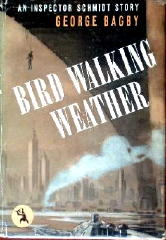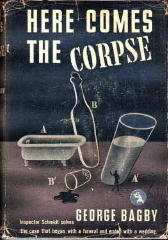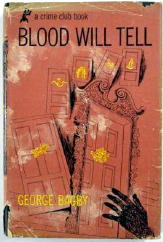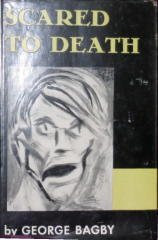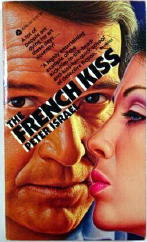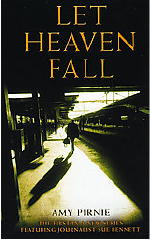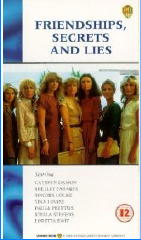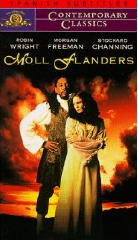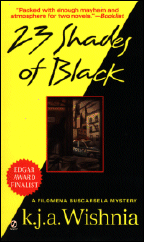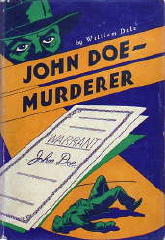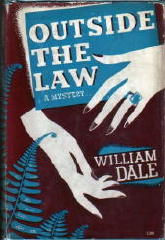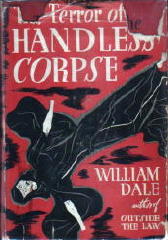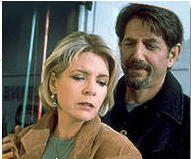December 2008
Monthly Archive
Wed 31 Dec 2008
GEORGE BAGBY – Guaranteed to Fade.
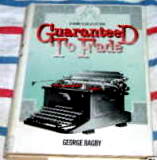
Doubleday Crime Club, hardcover, 1978. Hardcover reprint: Detective Book Club [3-in-1 edition], February 1979.
The first time that George Bagby, himself a character in his own novels, told us about one of the mystery cases solved by his friend, Inspector Schmidt of the N.Y.P.D., was in 1935. This is his latest, the 44th in the series so far.
As always, Schmitty complains a great deal about his aching feet, but he makes quick work of the murder of the many-times married Tommy Thomas, a prime example of how the rich find divorce so convenient a convention. To tell the truth, however, this one doesn’t take a lot of brain-power to figure out. The entertainment may be lighter than usual, but then again, I’m a confirmed addict.
— From The MYSTERY FANcier, Vol. 3, No. 4, July-Aug 1979. This review also appeared earlier in the Hartford Courant.
[UPDATE] 12-31-08. One thing that struck me when reading this review is that when I wrote them for the Courant, I generally had to keep them short, something I seem to have difficulty doing any more. Not that there’s anything wrong with that.
The other thing that caught my attention was the very last word I used. George Bagby, in real life Aaron Marc Stein, aka Hampton Stone was one of my favorite writers, under all three names. I cringe at having to use the word “was,” since (once again) he’s an author I haven’t read in an awfully long time. Going through these old fanzines is bringing back lots of memories.
In Mr. Bagby’s honor, and Inspector Schmidt’s as well, why not go for a long list of all of the latter’s adventures? Thanks to the Revised Crime Fiction IV, by Allen J. Hubin, here it is:
SCHMIDT, INSPECTOR [GEORGE BAGBY]
o Murder at the Piano (n.) Covici Friede 1935 [New York City, NY]
o Ring Around a Murder (n.) Covici Friede 1936 [New York]
o Murder Half Baked (n.) Covici Friede 1937 [New York City, NY]
o Murder on the Nose (n.) Doubleday 1938 [New York City, NY]
o Bird Walking Weather (n.) Doubleday 1939 [New York City, NY]
o The Corpse with the Purple Thighs (n.) Doubleday 1939 [New Jersey; Academia]
o The Corpse Wore a Wig (n.) Doubleday 1940 [New York City, NY]
o Here Comes the Corpse (n.) Doubleday 1941 [New York City, NY]
o Red Is for Killing (n.) Doubleday 1941 [New York City, NY]
o Murder Calling �50� (n.) Doubleday 1942 [New York City, NY]
o Dead on Arrival (n.) Doubleday 1946 [New York City, NY]
o The Original Carcase (n.) Doubleday 1946 [New York City, NY]
o The Twin Killing (n.) Doubleday 1947 [New York City, NY]
o In Cold Blood (n.) Doubleday 1948 [New York City, NY]
o The Starting Gun (n.) Doubleday 1948 [New York City, NY]
o Coffin Corner (n.) Doubleday 1949 [New York City, NY]
o Drop Dead (n.) Doubleday 1949 [New York City, NY]
o Blood Will Tell (n.) Doubleday 1950 [New York City, NY]
o Death Ain�t Commercial (n.) Doubleday 1951 [New York City, NY]
o The Corpse with the Sticky Fingers (n.) Doubleday 1952 [New York City, NY]
o Scared to Death (n.) Doubleday 1952 [New York City, NY]
o Dead Drunk (n.) Doubleday 1953 [New York City, NY]
o Give the Little Corpse a Great Big Hand (n.) Doubleday 1953 [New York City, NY]
o The Body in the Basket (n.) Doubleday 1954 [Madrid]
o A Dirty Way to Die (n.) Doubleday 1955 [New York City, NY]
o Cop Killer (n.) Doubleday 1956 [New York City, NY]
o Dead Storage (n.) Doubleday 1957 [New York City, NY]
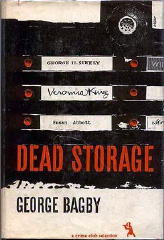
o Dead Wrong (n.) Doubleday 1957 [New York City, NY]
o The Three-Time Losers (n.) Doubleday 1958 [New York City, NY]
o The Real Gone Goose (n.) Doubleday 1959 [New York City, NY]
o Evil Genius (n.) Doubleday 1961 [New York City, NY]
o Murder�s Little Helper (n.) Doubleday 1963 [New York City, NY]
o Mysteriouser and Mysteriouser (n.) Doubleday 1965 [New York City, NY]
o Dirty Pool (n.) Doubleday 1966 [New York City, NY]
o Corpse Candle (n.) Doubleday 1967 [Maine]
o Another Day-Another Death (n.) Doubleday 1968 [New York City, NY]
o Honest Reliable Corpse (n.) Doubleday 1969 [New York City, NY]
o Killer Boy Was Here (n.) Doubleday 1970 [New York City, NY]
o My Dead Body (n.) Doubleday 1976 [New York]
o Two in the Bush (n.) Doubleday 1976 [New York City, NY]
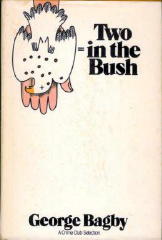
o Innocent Bystander (n.) Doubleday 1977 [New York City, NY]
o The Tough Get Going (n.) Doubleday 1977 [New York City, NY]
o Better Dead (n.) Doubleday 1978 [New York City, NY]
o Guaranteed to Fade (n.) Doubleday 1978 [New York City, NY]
o I Could Have Died (n.) Doubleday 1979 [New York City, NY]
o Mugger�s Day (n.) Doubleday 1979 [New York City, NY]
o Country and Fatal (n.) Doubleday 1980 [New York City, NY]
o A Question of Quarry (n.) Doubleday 1981
o The Sitting Duck (n.) Doubleday 1981
o The Golden Creep (n.) Doubleday 1982 [New York City, NY]
o The Most Wanted (n.) Doubleday 1983 [New York City, NY]
Wed 31 Dec 2008
Posted by Steve under
ReviewsNo Comments
SUSAN DONOVAN – Knock Me Off My Feet.
St. Martin’s; paperback original. First printing: December 2002.
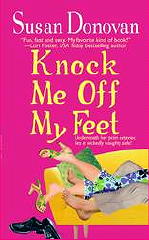
I was talking about novels of romantic suspense a short while back. This book isn’t quite what I had in mind, since what this is, when it comes down to it, is a romance novel, pure and simple, and nothing less.
On the other hand, the criminous element that’s involved is exactly where the story begins and where it ends. If in the meantime it meanders off into a more-or-less standard does-he-will-she kind of love affair, I certainly believe it’s legitimate for me to talk about it here, and very much so.
It starts when Chicago policeman Stacey Quinn is assigned to investigate who’s been sending threatening letters to the local equivalent of Martha Stewart, but he hardly expects “Homey Helen” to be breathtakingly beautiful Audie Adams. That may be the reason she’s also a woman that men tend to spook away from. In Quinn’s case, though, he’s the exception. It’s love at first sight.
There is also a murder involved, you should not be surprised to learn. Audie’s mother died in a mugging incident a few months earlier. She was the original Homey Helen, who made millions on how-to advice, but who was totally dysfunctional when it came to her own family.
The mystery and the crime-solving aspect of the investigation that are initiated from this are therefore real, albeit somewhat mechanical, nor is there any doubt about it — it’s the romance that causes the sparks.
And as a short note to the unwary, take that last word literally. The lovemaking is both explicit and graphic. If filmed as is, there’s no chance in the world the movie could ever be shown on TV, even on HBO or Cinemax.
— December 2002 (slightly revised)
Tue 30 Dec 2008
A 1001 MIDNIGHTS Review by Marcia Muller:
HILLARY WAUGH – The Con Game.
Doubleday Crime Club, hardcover, 1968. Paperback reprint: Popular Library, n.d. UK edition: Victor Gollancz, hc, 1986.
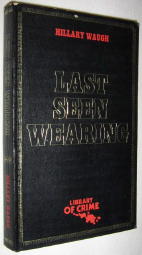
The novels of Hillary Waugh are characterized by tight plot lines that contain no superfluous action or complications. Each of his stories is lean, tense, and to the point, and it was this streamlined approach and good sense of structure that made Julian Symons select the 1952 novel Last Seen Wearing… for his list of the 100 greatest crime stories written up to 1959.
Over the past thirty-some years, Waugh — who is married to fellow suspense writer Shannon OCork — has created several series characters: private eyes Sheridan Wesley and Philip Macadam, who are both highly derivative of the Chandler/Hammett tradition; Lieutenant Frank Sessions of Manhattan’s Homicide North; and Police Chief Fred Fellows of Stockford, Connecticut.
Fellows, a down-to-earth, overweight cop and severe taskmaster, is probably the most appealing of these; and the small-town milieu is one Waugh knows well, since Stockford is very much like the Connecticut setting where Waugh grew up (although life there is definitely more fraught with peril than in New Haven).
The Con Game, Fellows’s eleventh case, is sharply evocative of the suburbs of the Sixties. Four couples have conspired to bribe elected officials in a land deal; now the $60,000 they have amassed to do so is missing, as are two of the conspirators, George and Dierdre Demarest.
Fellows’s job is to find them — and the money. His investigation reveals affairs, hopes of affairs, suspicions of affairs, revenge after affairs, and divorce because of affairs — in short, almost every kind of sexual misconduct in Stockford. And those citizens who are not motivated sexually are sure to be moved by greed.

Fellows treads carefully through this social minefield, trying to determine what each devious-minded person is hiding, but of course he cannot tread carefully enough. And before the case is over, he must use a creative method to determine the whereabouts of his quarry.
Fellows is an able police officer and a sympathetic character who employs not only good procedural methods but also the logical processes of classical detectives to get his woman or his man. Some of Waugh’s other books in this series are Sleep Long, My Love (1959), Born Victim (1962), and End of a Party (1965).
Among the Manhattan North novels are “30” Manhattan East (1968) and Finish Me Off (1970).
———
Reprinted with permission from 1001 Midnights, edited by Bill Pronzini & Marcia Muller and published by The Battered Silicon Dispatch Box, 2007. Copyright © 1986, 2007 by the Pronzini-Muller Family Trust.
HILLARY WAUGH, R.I.P. Although his obituary did not appear in the New York Times until last Friday, Mr. Waugh passed away earlier this month on December 8th. The obituary called him a “pioneer of the police procedural novel,” as indeed he was.
It ends by quoting him on the cardinal rule of mystery writing: “‘Authenticity is the key to good mystery writing,’ he told an interviewer. ‘Not only must you be able to write well, but you must also possess the instincts of a good reporter who has witnessed firsthand the darker side of human nature.'”
Tue 30 Dec 2008
PETER ISRAEL – The Stiff Upper Lip.
Thomas Y. Crowell Co., hardcover, 1978. Paperback reprint: Avon, 1980.
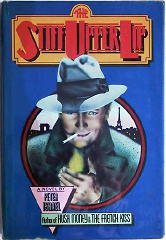
The private eye seems in essence to be almost wholly a uniquely American character. Even if B. F. Cage is originally from Los Angeles, by continuing to use the side streets and back alleys of Paris and Amsterdam as his stomping grounds, he stands out like a crime against nature.
His client this time around is a black basketball player trying a comeback in France, but certain past and present indiscretions involving mobs of two different nationalities are threatening to catch up with him. The story is slight, involving no particular urgency, and it ends with an awfully silly version of a Chicago gang war.
Too many transplants, and they fail to take. Valerie, Cage’s newly self-appointed assistant, is the only delicious morsel to be found anywhere in this stale and condescending affair.
– From The MYSTERY FANcier, Vol. 3, No. 4, July-Aug 1979. This review also appeared earlier in the Hartford Courant.
[UPDATE] 12-30-08. As a wild shot in the dark, I’d say that fictional PI’s are a world-wide phenomenon today, which is a Good Thing. And in the years since 1979, I think that these foreign born PI’s have adapted and changed. They display much more of their own countries’ backgrounds and flavors, instead of relying so heavily on the US model. (A point worth considering in more detail, someday.)
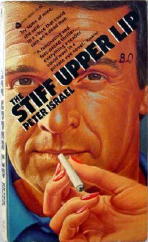
Just from reading through this review, I also think I might enjoy The Stiff Upper Lip more now than I did in 1979. Not having read it again in the almost 30 years since, all I can pass along to you is my judgment as it was back then.
Over the years Peter Israel, the author, was also a high-ranking editor at Putnam. He eventually became the president, then chairman of the board of directors, serving in these capacities between 1978 and 1987.
Of more specific interest to us, he also wrote five mystery novels, three with B. F. Cage and two with “eccentric, brilliant New York City legal detective Charles Camelot and his assistant, Phil Revere,” as they’re described on one bookseller’s website.
Here’s a list of all five, as taken from the Revised Crime Fiction IV, by Allen J. Hubin:
ISRAEL, PETER. Pseudonym of J. Leon Israel.
Hush Money (n.) Crowell 1974 [B. F. Cage; Los Angeles, CA]
The French Kiss (n.) Crowell 1976 [B. F. Cage; Paris]
The Stiff Upper Lip (n.) Crowell 1978 [B. F. Cage; Paris]
I’ll Cry When I Kill You (n.) Mysterious Press 1988 [Charles Camelot; New York City, NY]
If I Should Die Before I Die (n.) Mysterious Press 1989 [Charles Camelot; New York City, NY]
Tue 30 Dec 2008
Posted by Steve under
Authors ,
ReviewsNo Comments
REVIEWED BY WALTER ALBERT:
SUE GRAFTON – Q Is for Quarry. G.P. Putnam’s Sons, hardcover, 2002. Reprint paperback: Berkley, 2003.
ROBERT B. PARKER – Potshot. Putnam, 2001. Reprint paperback: Berkley, 2002.
In recent novels, Kinsey Millhone has been rediscovering her family and she’s not at all happy about it. The main plot line in Q Is for Quarry concerns an eighteen-year-old cold case that two aging cops (Lt. Con Dolan and retired detective Stacey Oliphant) are attempting to solve.
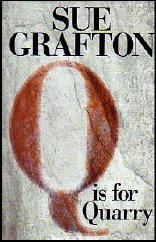
Oliphant’s non-Hodgkin’s lymphona has reappeared after ten years in remission, and Dolan is an incessant smoker who’s had a series of heart attacks that have put him on medical disability. As a young cop Dolan was called to the scene of the discovery of the body of a young woman, while Oliphant was one of the original investigating officers.
The woman was never identified. Dolan asks Kinsey to help out and, with both men intermittently sidelined because of their health problems, it’s her usual careful, methodical legwork that eventually closes the case.
In Potshot, Spenser is hired by a woman to find out who murdered her husband, and he heads off to to Potshot, Arizona, where she and her husband run a “little tourist service.”
He finds the town is largely controlled by a community of outcasts and misfits who have been molded by their leader, the messianic Preacher, into a formidable and deadly force. Spenser, hired by the town’s leaders to clean out the “Dell” where the Preacher and his cohorts hole up, brings in his own force for assistance.
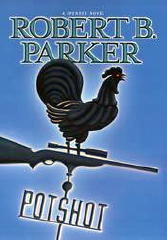
However, he begins to suspect that nothing is exactly as it appears to be, a realization that doesn’t detour the clean-up but makes it something less than the top priority for Spenser, which is to find out the truth.
The two writers, apart from their common ability to tell a good story, approach that task quite differently. Parker is the terse, concise stylist, who gives the impression of not having an unnecessary ounce of padding in his narratives.
This sometimes leads to a concision that sets my teeth on edge, but only momentarily. (There’s a very awkward moment with Susan when Spenser fractures the French language in a bit of inelegant linguistic playfulness, and I rather liked it that his uptight lady friend was, as ever, correct, and Spenser was rather bluntly incorrect.)
Grafton is digressive and expansive, probably more so than in her earliest work, but the solid, hard-nosed investigations she undertakes still draw me in, even as I wish that she would let Kinsey deal more directly with her ambivalent feelings about her family and either move on past them or find some measure of reconciliation with them.
The two novels, by writers of long-running series and still apparently professionally comfortable with what they’re doing, should satisfy their many fans among whom I still count myself.
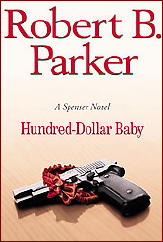
[COMMENT] This and the next batch of reviews from me, some of them going back quite a way, are of books by writers I’ve been following over the years. I’m increasingly tired of writing about series in which the quality doesn’t vary significantly from one title to the next. I’ll use this as a way of signing off on some of them.
Four years after I wrote the reviews of these two books, I read Parker’s Hundred-Dollar Baby (Putnam, 2006; Berkley, 2007). Spenser takes on a case for April Kyle, whom he once helped off the streets and into a “safer” line of employment.
Good works don’t always turn out well in the end. Another smart, smooth performance by Parker. And unless Parker falls from his pedestal, pulled down by a dumb, clumsy performance, that’s my final word on the Spenser series.
Mon 29 Dec 2008
More authors from the D-H section of the annotated online Addenda for the Revised Crime Fiction IV, by Allen J. Hubin.
PLEASE NOTE: This will be the last of the Addenda updates to appear on the M*F blog, I’m sorry to say. To post them here as well as there takes time and effort I’ve decided I could use more effectively elsewhere. What I’ll be doing instead is putting together a list of interested parties to whom I’ll send updates like this one by email on a regular basis. If you’d like to be on the list, leave a comment or contact me directly, and I’ll make sure you are.
DAVIES, FREDA. 1937- . Add year of birth. Born in London; read zoology at Bristol University and taught for a while before moving to Pembrokeshire. Add SC: science reporter Sue Bennett, in the title below and at least one later novel, post-2000. Pseudonym: Amy Pirnie, q.v.
Let Heaven Fall. Allison, UK, pb, 1995; Carroll & Graf, US, hc, 2006, as by Amy Pirnie (shown). “Accidental death, judges the coroner, but was it simply a case of solicitor Colin Bennett falling under a rush-hour train?”
DAVIS, ELIZABETH.
There Was an Old Woman. TV movie: Mark Carliner, 1971, as Revenge (scw: Joseph Stefano; dir: Jud Taylor)
DAVIS, GIL. Add as a new author. SC: Dan Walker, who does undercover assignments for the CIA, in all titles.
Assignment: Tokyo. Publishers Export, pb, 1967. Setting: Tokyo.
Missile Island. Publishers Export, pb, 1967. Setting: Caribbean.
Valley of the Doles. Publishers Export, pb, 1967. Setting: Texas (El Paso).
DEAL, BABS.
The Walls Came Tumbling Down. TV movie: Whittman, 1979, as Friendships, Secrets, and Lies (scw: Joanna Crawford; dir: Ann Zane Shanks, Marlena Laird). [Note: Filmed and produced with an all female cast, with only one male in the crew, a cinematographer.]
DEFOE, DANIEL.
The Fortunes and Misfortunes of the Famous Moll Flanders. Film: MGM, 1996, as Moll Flanders (scw & dir: Pen Densham). TV movie: BBC, 1975, as Moll Flanders (scw: Hugh Whitemore; dir: Donald McWhinnie). Also: ITV/PBS, 1996, as The Fortunes and Misfortunes of Moll Flanders (scw: Andrew Davies; dir: David Attwood). [Shown is the DVD case for the 1996 MGM film.]
DELMAN, DAVID. TV movie, based on an unidentified novel: Lorimar, 1975, as Conspiracy of Terror (scw: Howard Rodman; dir: John Llewellyn Moxey). SC: Lt. Jacob Horowitz (Michael Constantine) [and Barbara Rhoades as Helen Horowitz].
[Note: Taken from imdb.com is a brief plot summary of the film above. If you can match the storyline with the book, please let Al or me know: A husband-and-wife detective team investigate the existence of satanic cults involved in murder, while the husband battles with his Orthodox Jewish parents who haven’t forgiven him for marrying a non-Jewish woman. Delman’s books published in 1975 and before are:
Sudden Death,
A Week to Kill,
He Who Digs a Grave, and
One Man’s Murder.]
Mon 29 Dec 2008
K. j. a. WISHNIA – Red House.
St. Martin’s; paperback reprint, December 2002. Hardcover edition: St. Martin’s, November 2001.
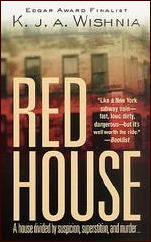
This is the fourth in the series of mysteries solved by Ecuadorian ex-revolutionary and now fledgling private eye Filomena Buscarsela, single mom and philosopher slash social critic. Quoting from page 67: “And thus we see the dangers of post-Heideggerian rejection of history.”
Since I haven’t read the previous three books, I don’t know exactly what career paths she may have been following up to now. She seems to have spent some time on the New York City police force — a police detective for only one day, as she puts it — but in this book, she’s a first year trainee at the PI firm of Davis and Brown, trying to work her way up to getting her own license.
And rather than focusing on only one case, we get bits and pieces of a number of them — more of a private eye procedural, a la Joe Gores, street style, as Filomena tries to build up the Latino clientele for the firm.
The mugging (murder?) of a local housing advocate is the main item on her agenda, however, with the plight of the illegal squatters in an abandoned tenement they refurbished themselves a close second.
The pace is fast-moving, told in first person, present tense, and Filomena certainly knows her way around. The problem with the book is a subtle one, as I found it. According to the back cover, Wishnia (male) has a Ph.D. in comparative literature, and book reads as though it was written by someone having a Ph.D. in comparative literature.
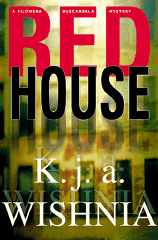
It does not read as though it was being told by a real-life Filomena Buscarsela, whose depth of knowledge seemingly knows no bounds, running the gamut from Heidegger (see above) to Marx (Groucho, waggle-waggle) to pulp novel covers (page 131) to nineteenth-century German chemist Friedrich Kekulé (page 226).
I’m not saying that Filomena Buscarsela is not the person she says she is. What I’m saying is that K. j. a. Wishnia did not succeed in convincing me that she is. It’s his job, and so far (I’ve read only the one book) he hasn’t done it, at least not for me.
The street scenes are fine, perhaps even more than fine. Otherwise? I’m skeptical, but I’ll leave myself open to opposing argument. (Even better, I’ll read the first three books.)
— December 2002 (revised)
[UPDATE] 12-29-08. That’s another promise I haven’t kept, I’m sorry to say. Not yet, I haven’t, but I will. For the record, expanded upon from her entry in the Revised Crime Fiction IV, by Allen J. Hubin, here’s a list of all of Filomena’s appearances in book form:
BUSCARSELA, FILOMENA
23 Shades of Black. The Imaginary Press, trade pb, 1997. Signet, pb, Nov 1998; Point Blank, trade pb, 2004. [Edgar Award finalist for Best First Novel.]
Soft Money. Dutton, hc, 1999; Signet, pb, May 2000.
The Glass Factory. Dutton, hc, 2000; Signet, pb, Mar 2001.
Red House. St. Martin’s, hc, Nov 2001; St. Martin’s, pb, Dec 2002.
Blood Lake. St. Martin’s, hc, Dec 2002.
Sun 28 Dec 2008
Here are the first entries in the newly created D-H section of the online Addenda to the Revised Crime Fiction IV, by Allen J. Hubin.
DALE, WILLIAM. One of many pseudonyms of writer Norman A. Daniels, q.v. Under this pen name, the author of three works listed in the Revised Crime Fiction IV.
_Corpse, Hands Off! See The Terror of the Handless Corpse.
John Doe–Murderer. Gateway, hc, 1942. United Authors, UK, 1946. Australian title: Murder Has No Name. Phantom, pb, 1955.
_Murder Has No Name. See John Doe–Murderer.
Outside the Law. Dodge, hc, 1938. Add setting: Denver, Wyoming. Leading characters: Jeff Tracy, thief, and Douglas Greer, detective.
The Terror of the Handless Corpse. Gateway, hc, 1939. Australian title: Corpse, Hands Off! Phantom, pb, 1955. Setting: New York. Leading character: PI Loopy Jones.
DALEY, ROBERT.
To Kill a Cop. TV movie: David Gerber, 1978 (scw: Ernest Tidyman; dir: Gary Nelson)
DANIELS, HAROLD R.
House on Greenapple Road. TV movie: Quinn Martin, 1970 (scw: George Eckstein; dir: Robert Day)
DANIELS, NORMAN A. Pseudonyms: William Dale, q.v., Daniella Dorsett, Harrison Judd, Mark Reed, Norman T. Vane & David Wade; house pseudonyms James Clayford, G. Wayman Jones & Robert Wallace; ghostwriter for Dorothy Daniels; hence also Angela Gray, Cynthia Kavanaugh, Suzanne Somers, Geraldine Thayer & Helen Gray Weston. Prolific writer for the pulps as well as the author of many titles cited in the Revised Crime Fiction IV.
Chase. Novelization of TV movie [pilot for series]: Mark VII/Universal, 1973 (scw: Stephen J. Cannell, dir: Jack Webb)
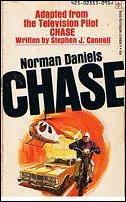
DAVIDSON, MURIEL (FRIEDLAND). 1923-1983. Correction of year of birth; add maiden name. A television executive and the author of three mystery novels included in the Revised Crime Fiction IV. She was found murdered at her California home on September 27, 1983, her killer a man whom she had met at a hospital where she counseled alcoholics once a week.
The Thursday Woman. TV movie: CBS, 2000, as The Wednesday Woman (scw: N. D. Schreiner; dir: Christopher Leitch). Note: In this semi-biographical suspense thriller, a woman, Muriel Davidson, writes a novel about a reckless affair with a dangerous criminal, then lives out the story she has created. Davidson is played by Meredith Baxter on the screen. No onscreen credit is given to the book as the source of the screenplay. [For more on the story, see this earlier post on the M*F blog.]
Sun 28 Dec 2008
Posted by Steve under
ReviewsNo Comments
THE CURMUDGEON IN THE CORNER
by William R. Loeser
Editorial introduction: As was Mr. Loeser’s custom, he often extended his reviews into criticism, in which case he discussed more details of the plot than might otherwise be warranted. This is one of those occasions.
P. D. JAMES – Cover Her Face. Faber & Faber, UK, hardcover, 1962. Charles Scribner’s Sons, US, hc, 1966. Reprinted many times in both hardcover and paperback.
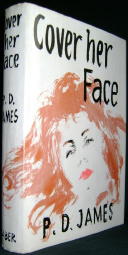
P. D. James is looked upon as the Sayers-Christie-Allingham of our time, and I have, I hope, made the mistake of reading her first book, Cover Her Face twice and her others not at all. I say I hope I’ve made a mistake, for this for this title is not a detective story and abounds in wrongheaded ideas.
The book begins with 40-50 pages of foreboding in the best tradition of a gothic. The story revolves around Sally Jupp, who has been rescued from the local home for unwed mothers to be the housemaid at the country house Martingale by the materfamilias, Mrs. Eleanor Maxie.
The rest of the household consists of the comatose Mr. Maxie; widowed daughter Deborah Riscoe; usually, her diffident suitor, Felix Hearne; son Stephen, when he can get away from his duties as resident at a London hospital; and Catherine Bowers, a nurse who keeps inviting herself in hopes of embarrassing a proposal out of Stephen.
Sally makes herself unpopular by pranks against the loyal and long-serving housekeeper Martha and family members and produces the topper by announcing that Stephen has proposed to her. That night she is strangled in bed.
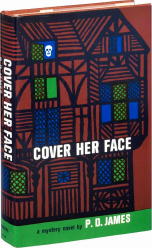
Chief Inspector Adam Dalgleish arrives on the scene and has to unravel a below-stairs plot and, the unlikely presence of two outsiders on the scene at the time of death.
All of this brings him little closer to a case that would convince a jury against the murderer, but Mrs. Maxie removes his difficulties by confessing she killed Sally to protect the family honor, adding that she had delayed her confession until her husband died, so he wouldn’t have to be taken to a nursing home.
The female characters are pictured as admirable for their ability to understand and cope with domestic crises without panicking. Stephen, on the other hand, is looked down upon for his idealism and lack of interest in these domestic trivia as evidenced by the fact that he goes back to work during the investigation.
That he is attempting to add to rather than live off, as they do, the family fund is ignored. Hearne is packed off to Canada, his fault being an understandable slightness of concern over the family’s difficulties after having had his fingernails extracted by the Nazis.
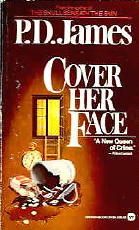
Sally, it turns out, had been robbed by her guardian and was married all along to a “nice young man,” who was off making his fortune in Venezeula. She had gone the unwed mother route to save money. Would that she had been permitted to live to stick a few more pins in these stuffed blouses.
The nice young man, poor devil, is allotted to the husband-seeking Catherine. Dalgleish, whom the author looks upon as God, is, aside from one reference to a dead wife and child, given as much personality as Dr. Priestly. At the end of the book we are led to believe he will mate with Deborah, his recommendation being, I suppose, that he sent her mother off to the Big House on the day her father died.
Maybe there is something to the book to cause such a violent and lengthy reaction.
– From The MYSTERY FANcier, Vol. 3, No. 4, July-Aug 1979 (slightly revised).
[UPDATE] 12-28-08. I asked Bill earlier this month about the first sentence of his review. His reply:
“I recall that I did indeed read this book twice, although why I should have persisted the second time beats me! I still recall how much I disliked the book, so much so that I never attempted another by her.”
Sun 28 Dec 2008
Posted by Steve under
ReviewsNo Comments
A REVIEW BY STEPHEN MERTZ:
W. T. BALLARD – Murder Can’t Stop.
David McKay Co., hardcover, 1946. Paperback reprint: Graphic #26, 1950.
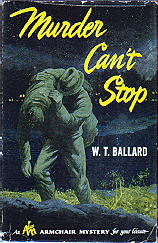
I had high hopes for this one. W. T. Ballard was a prominent Black Mask writer and a friend and contemporary of both Hammett and Chandler, and I found his first novel (Say Yes to Murder, 1942) to be a fine Hollywood tough guy mystery.
Murder Can’t Stop was Ballard’s second book and, like the first, stars Bill Lennox, trouble shooter on call for General Consolidated Studios; a character Ballard had introduced in Black Mask in the early Thirties.
Another promising feature was that this second Lennox adventure is a “corrupt town” novel, my favorite sub-genre of the hardboiled form (i.e., hero is in provincial community to unravel a murder and finds that the town is controlled from top to bottom by two or more criminal-political factions. Hero proceeds to solve the murder and almost incidentally clean up the town by the simple expedient of playing the various corrupt factions off against each other).
But after all the high hopes, Murder Can’t Stop proved, unfortunately, to be a major disappointment. The book is just too busy to succeed.
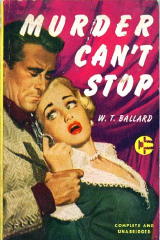
The setting is right: Lennox is in a one horse mining burg in northern California, nursemaiding a Consolidated star who’s been ordered to sober up by the head office. There’s murder — the body is found in Lennox’s own bed — and more murder (five in all) and the more Bill investigates, the more layers of corruption and deceit he uncovers beneath the town’s outwardly sedate veneer.
Indeed, there are more plots and subplots here than in a Lew Archer story. And that’s the problem.
What should have been a novel of pace and characterization becomes so preoccupied with the detailing of treachery and doublecrossing between the principals of the overpopulated cast that there’s little space left for the character development necessary for any of it to mean very much.
This is most disappointing in the case of Lennox, who in Say Yes to Murder emerged as a likeable, believably complex hero of the medium-to-hardboiled type.
Murder Can’t Stop is, sad to say, recommended for Ballard completists only.
– From The MYSTERY FANcier, Vol. 3, No. 4, July-August 1979.
[EDITORIAL COMMENT] For a complete list of all of Ballard’s book-length mystery fiction, please see my review of Lights, Camera, Murder, a Bill Lennox novel that he wrote in 1960 as a paperback original by John Shepherd. It was posted here last year on the blog. — Steve
Next Page »

